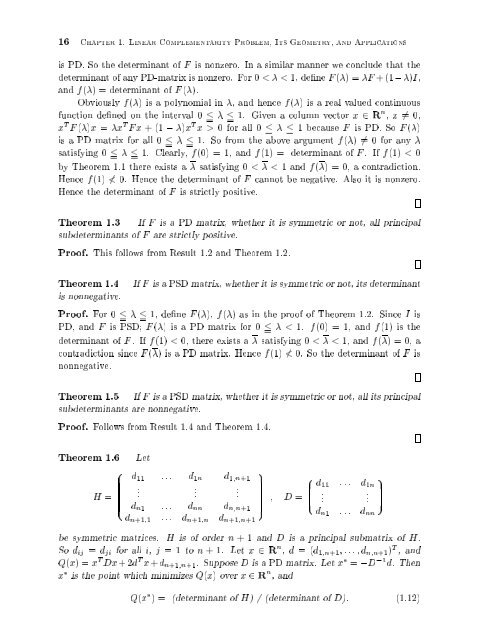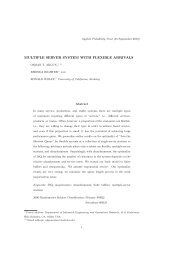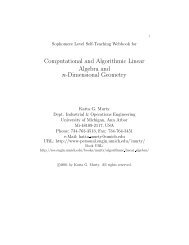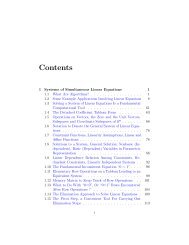Chapter 1 LINEAR COMPLEMENTARITY PROBLEM, ITS ...
Chapter 1 LINEAR COMPLEMENTARITY PROBLEM, ITS ...
Chapter 1 LINEAR COMPLEMENTARITY PROBLEM, ITS ...
You also want an ePaper? Increase the reach of your titles
YUMPU automatically turns print PDFs into web optimized ePapers that Google loves.
16 <strong>Chapter</strong> 1. Linear Complementarity Problem, Its Geometry, and Applications<br />
is PD. So the determinant of F is nonzero. In a similar manner we conclude that the<br />
determinant ofany PD-matrix is nonzero. For 0 < 0 for all 0 < = < = 1 because F is PD. So F ( )<br />
is a PD matrix for all 0 < = < = 1. So from the above argument f( ) 6= 0 for any<br />
satisfying 0 < = < = 1. Clearly, f(0) = 1, and f(1) = determinant of F . If f(1) < 0<br />
by Theorem 1.1 there exists a satisfying 0 < < 1 and f( ) = 0, a contradiction.<br />
Hence f(1) 6< 0. Hence the determinant of F cannot be negative. Also it is nonzero.<br />
Hence the determinant of F is strictly positive.<br />
Theorem 1.3 If F is a PD matrix, whether it is symmetric or not, all principal<br />
subdeterminants of F are strictly positive.<br />
Proof. This follows from Result 1.2 and Theorem 1.2.<br />
Theorem 1.4 If F is a PSD matrix, whether it is symmetric or not, its determinant<br />
is nonnegative.<br />
Proof. For 0 < = < = 1, de ne F ( ), f( ) as in the proof of Theorem 1.2. Since I is<br />
PD, and F is PSD F ( ) is a PD matrix for 0 < = < 1. f(0) = 1, and f(1) is the<br />
determinant of F . If f(1) < 0, there exists a satisfying 0 < :<br />
d11 ::: d1n d1n+1<br />
.<br />
dn1 ::: dnn dnn+1<br />
dn+11 ::: dn+1n dn+1n+1<br />
.<br />
.<br />
9<br />
><br />
D =<br />
8<br />
>:<br />
d11 ::: d1n<br />
.<br />
.<br />
dn1 ::: dnn<br />
be symmetric matrices. H is of order n +1 and D is a principal submatrix of H.<br />
So dij = dji for all i, j = 1 to n +1. Let x 2 R n , d = (d1n+1:::dnn+1) T , and<br />
Q(x) =x T Dx+2d T x + dn+1n+1. Suppose D is a PD matrix. Let x = ;D ;1 d. Then<br />
x is the point which minimizes Q(x) over x 2 R n , and<br />
Q(x )= (determinant ofH) / (determinant of D). (1:12)<br />
9<br />
>










